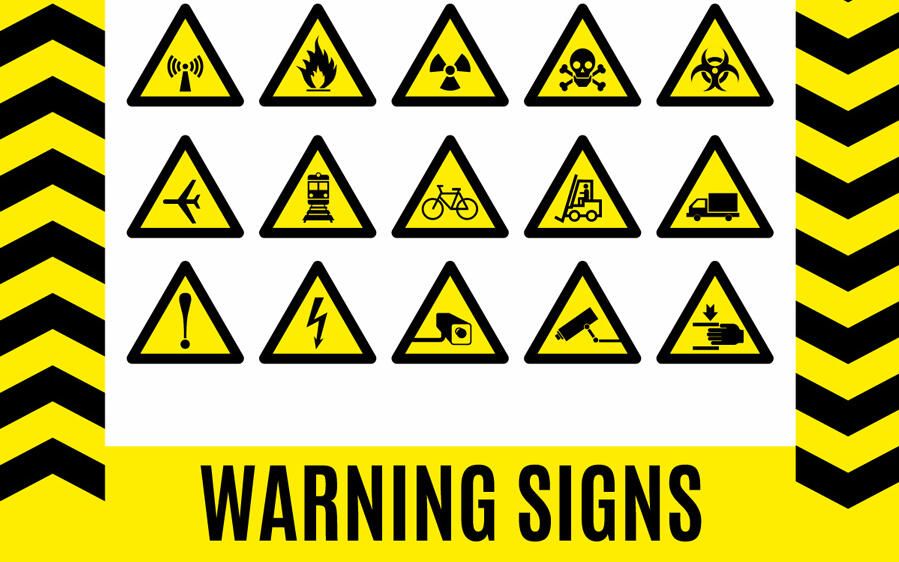Engaging Introduction: The Critical Intersection of Signage and Safety
In today’s fast-paced world, where safety is paramount, the importance of clear and effective signage cannot be overstated. Imagine this scenario: a bustling warehouse where every second counts, and safety is the thread holding the chaos at bay. In such an environment, a well-placed safety sign can be the difference between a regular day at work and an avoidable accident.
Signage, in its essence, is a silent guardian. It guides, warns, and informs, often without us even realising its presence. Yet, its impact is profound. Consider the statistics: According to a report by the Health and Safety Executive (HSE) in the UK, a significant number of workplace injuries could be prevented with better hazard communication. This startling revelation underscores the unspoken power of effective signage.
But what exactly makes signage so pivotal in ensuring safety and compliance? Is it merely about putting up a sign anywhere? Certainly not. The art of signage blends psychology, design, and legal compliance to create a communication tool that transcends languages and literacy levels. It's about delivering critical information efficiently and effectively, ensuring that everyone, regardless of their role or background, understands the potential hazards and necessary precautions in their environment.
As we delve deeper into the world of signage and safety, we uncover layers of complexity and necessity. From the basic 'Fire Exit' signs that guide us to safety, to the more specific 'High Voltage' warnings that protect us from unseen dangers, each sign plays a crucial role in our daily safety. It’s a silent language that speaks volumes about care, caution, and compliance.
In this comprehensive guide, we will explore the multifaceted role of signage in maintaining safety, the legalities surrounding it, and how effective signage design can create safer spaces for everyone. Whether you’re a business owner, a safety officer, or simply someone who values the importance of a well-informed environment, this exploration into the world of safety signage promises to be both enlightening and essential.
The Role of Signage in Safety in Ireland
In Ireland, where both historical charm and modern industry coexist, the role of safety signage is not just a matter of compliance but a vital component of everyday life. From the bustling streets of Dublin to the serene landscapes of the countryside, safety signs are ubiquitous, silently ensuring the well-being of residents and visitors alike.
A. Understanding Safety Signage in the Irish Context
Safety signage in Ireland adheres to specific regulations and standards, primarily guided by the Health and Safety Authority (HSA). These signs are not mere suggestions; they are a critical part of ensuring safe practices in various environments - be it in construction sites, offices, public spaces, or factories. In Ireland, the design, placement, and maintenance of these signs are governed by the Safety, Health and Welfare at Work (General Application) Regulations 2007, which align with the broader European Union directives.
B. Types of Safety Signs and Their Significance
In Ireland, safety signs are categorised into several types, each serving a distinct purpose:
- Prohibition Signs: These signs, often red and white, indicate actions that are strictly prohibited, such as 'No Smoking' or 'Do Not Enter'.
- Warning Signs: Characterised by their yellow and black colouring, these signs warn about potential hazards like 'High Voltage' or 'Wet Floor'.
- Mandatory Signs: Blue and white in appearance, these signs dictate specific actions that must be taken, such as 'Wear Safety Helmets'.
- Emergency Information Signs: Green and white, these signs indicate emergency exits, first aid stations, or routes to safety.
C. The Psychological Impact of Safety Signage
The effectiveness of safety signage in Ireland also hinges on its psychological impact. These signs are designed to be immediately noticeable and easily understandable. Their colours, shapes, and symbols are chosen based on how the human brain processes visual information. For instance, the colour red is universally associated with danger and commands attention, making it effective for prohibition signs.
D. Signage as a Tool for Prevention and Compliance
In Ireland, safety signs do more than just inform; they are a proactive measure in preventing accidents and injuries. By clearly marking potential hazards and providing necessary instructions, they help in creating a safe and compliant environment. This is particularly crucial in industries where risks are high, and the cost of non-compliance can be severe, both legally and ethically.
E. The Evolving Landscape of Safety Signage in Ireland
With technological advancements and changes in work environments, the landscape of safety signage in Ireland is continually evolving. Digital signage, interactive warning systems, and augmented reality (AR) are beginning to find their place alongside traditional signs, offering dynamic and adaptable solutions to safety communication.
In conclusion, the role of safety signage in Ireland is a testament to the country's commitment to safety and compliance. These signs are not just statutory requirements; they are integral to the fabric of Irish society, ensuring that safety is a shared responsibility and a collective benefit. As we navigate through Ireland's diverse settings, these signs serve as constant reminders of the importance of vigilance and care in our daily interactions with the world around us.
Ireland's Legal Compliance and Signage
In the Republic of Ireland, the realm of safety signage is not just a matter of good practice but a legal requirement, deeply embedded in the country's health and safety legislation. This section delves into the intricate web of legal compliance surrounding signage in Ireland, underscoring its critical role in maintaining safe and compliant environments.
A. The Legislative Framework
The cornerstone of safety signage legislation in Ireland is the Safety, Health and Welfare at Work Act 2005, complemented by the Safety, Health and Welfare at Work (General Application) Regulations 2007. These laws establish the foundational requirements for employers and occupiers of premises to ensure that safety signs are used where risks cannot be avoided or sufficiently reduced.
B. The European Influence
Irish law on safety signage is harmonised with European Union directives, particularly the EU Directive 92/58/EEC, which specifies minimum requirements for the provision of safety signs at work. This alignment ensures that safety standards across Ireland are consistent with broader European safety norms, facilitating a unified approach to risk management.
C. Categories of Compliance
- Risk Assessment: Employers are required to conduct thorough risk assessments to identify where safety signs are necessary.
- Signage Specifications: The law stipulates specific requirements regarding the design, colour, and pictograms of safety signs, ensuring uniformity and recognisability.
- Maintenance and Inspection: Regular maintenance and inspection of safety signs are mandated to ensure their continued effectiveness and compliance.
D. Employer Responsibilities
Employers in Ireland bear the primary responsibility for ensuring compliance with safety signage regulations. This includes:
- Selecting appropriate signs for specific hazards.
- Ensuring the signs are correctly positioned and clearly visible.
- Providing training and information to employees about the meanings of signs and the actions required upon encountering them.
E. Penalties for Non-Compliance
Non-compliance with safety signage regulations can result in significant penalties, including fines and legal action. The Health and Safety Authority (HSA) is responsible for enforcing these regulations, and failure to comply can lead to stringent enforcement actions, underscoring the seriousness with which safety signage is regarded in Irish law.
F. Evolving Standards
The standards and regulations governing safety signage in Ireland are not static; they evolve to reflect new risks, technologies, and best practices. Employers and premises managers must stay informed about these changes to ensure ongoing compliance.
G. The Broader Impact of Compliance
Beyond the legal implications, compliance with signage regulations in Ireland plays a critical role in cultivating a culture of safety. Adherence to these standards reflects an organisation's commitment to the well-being of its employees, customers, and the general public.
The landscape of legal compliance and signage in Ireland is comprehensive, reflecting the country's dedication to creating safe work and public environments. Navigating this landscape requires a thorough understanding of the legal requirements and a commitment to implementing them effectively. This not only ensures adherence to the law but also demonstrates a fundamental respect for the safety and well-being of all individuals within the Irish community.
Best Practices for Effective Signage
Effective signage is not merely about compliance with legal standards; it's an art that combines clarity, visibility, and universal understanding to ensure safety and guidance. Whether in a bustling city centre, a quiet village, or a busy workplace, the principles of effective signage remain constant. This section outlines best practices for creating and implementing effective signage, ensuring that it serves its intended purpose efficiently and effectively.
A. Clarity and Simplicity
- Concise Messaging: Signs should convey their message briefly and clearly. Avoid overloading signs with too much information, which can lead to confusion.
- Universal Symbols: Use universally recognised symbols and pictograms. This ensures that even those with language barriers or literacy challenges can understand the message.
B. Visibility and Readability
- Appropriate Sizing: Signs should be large enough to be easily read from a distance but not so large as to be obtrusive.
- Contrasting Colours: Use colours that stand out from the background and ensure that text and symbols have high contrast for easy readability.
- Lighting: Ensure signs are well-lit, either through natural or artificial means, especially in areas with low ambient light.
C. Strategic Placement
- Location: Place signs at eye level and in locations where they can be easily seen. They should be positioned near the relevant hazard or point of interest.
- Directional Flow: In cases where signs are guiding a pathway or direction, they should be placed at regular intervals to guide the individual along the correct path.
D. Consistency
- Standardised Design: Use a consistent design template for all signs to create a cohesive look and feel. This includes consistent use of colours, fonts, and symbols.
- Branding Considerations: If applicable, incorporate your brand's colours or logo subtly, ensuring it doesn’t detract from the sign's primary message.
E. Durability and Maintenance
- Weather-Resistant Materials: Choose materials that can withstand local weather conditions, be it rain, sun, or snow.
- Regular Inspections: Conduct regular checks to ensure signs are in good condition, visible, and up to date.
F. Legal Compliance and Updating
- Regulatory Alignment: Make sure your signage is in alignment with the latest legal and safety guidelines.
- Updates and Revisions: Be prepared to update signage when regulations change or new risks are identified.
G. Inclusivity and Accessibility
- Accessibility Considerations: Ensure that signage is accessible to all, including those with disabilities. This could involve Braille for the visually impaired or lower-placed signs for wheelchair users.
- Cultural Sensitivity: Be aware of cultural differences and sensitivities, especially in diverse communities.
H. Employee Training and Awareness
- Regular Briefings: Ensure that all employees are aware of what the signs mean and the importance of adhering to them.
- Feedback Mechanisms: Encourage feedback from employees and visitors about the effectiveness of the signage.
Effective signage is a critical component of safety and navigation in any environment. By adhering to these best practices, you can ensure that your signage is not only compliant but also effective in communicating vital information, thus contributing to a safer and more informed community or workplace.
Case Studies or Real-Life Examples
Examining real-life examples and case studies provides invaluable insights into the practical applications and impact of effective signage. These scenarios highlight how well-designed and strategically placed signs can significantly enhance safety and prevent accidents. Here are some illustrative case studies from various settings:
Case Study 1: Industrial Workplace Incident Prevention
- Context: A manufacturing facility in Cork experienced a series of minor accidents near a high-traffic forklift operating area.
- Problem: An investigation revealed that existing signage was inadequate, leading to workers inadvertently walking into the forklift path.
- Solution: The facility introduced clear, brightly coloured floor markings and warning signs indicating the forklift operating area. Additional signs were placed at eye level at all entrances to the area, alerting workers to the potential hazard.
- Outcome: There was a marked decrease in near-miss incidents, and workers reported feeling safer and more aware of their surroundings.
Case Study 2: Public Safety During a Festival
- Context: During a major cultural festival in Galway, organisers faced the challenge of managing large crowds in a confined space.
- Problem: Previous festivals saw instances of overcrowding and confusion, particularly near emergency exits and first aid stations.
- Solution: The organisers implemented a comprehensive signage strategy, including large, easily visible emergency exit signs and directional signs for first aid stations. They also used ground markings to guide foot traffic.
- Outcome: The festival saw improved crowd movement and quicker responses to emergency situations, with attendees praising the clear directions and information.
Case Study 3: Retail Store Navigation Enhancement
- Context: A large retail store in Dublin was renovating and reorganising its layout.
- Problem: Customers often found it challenging to locate specific departments, leading to frustration and reduced shopping satisfaction.
- Solution: The store introduced a new signage system, utilising both overhead and aisle-level signs with large, readable fonts and icons representing different product categories.
- Outcome: Customer feedback was overwhelmingly positive, with many noting the ease of navigation and time saved. The store also observed an increase in sales in previously hard-to-find sections.
Case Study 4: Hospital Wayfinding Improvement
- Context: A hospital in Limerick sought to improve its wayfinding system to enhance patient and visitor experience.
- Problem: Visitors and patients often found it difficult to navigate the complex hospital corridors, leading to missed appointments and stress.
- Solution: The hospital implemented a new signage system with clear, consistent designs and colour-coded sections. Signage included both wall signs and floor graphics.
- Outcome: The new signage system significantly reduced confusion, and the hospital received positive feedback from patients and visitors about the improved navigational experience.
These case studies demonstrate the tangible benefits of effective signage in diverse environments. From enhancing workplace safety to improving public event management and customer satisfaction, well-thought-out signage strategies can lead to significant improvements in efficiency, safety, and overall experience.
Integration of Technology in Signage
The integration of technology in signage represents a revolutionary step in how we communicate safety, directions, and information. In this era of rapid technological advancement, digital and interactive signage is becoming increasingly prevalent, offering dynamic, adaptable, and engaging ways to convey messages. This section explores the various technological innovations in signage and their implications for safety, information dissemination, and user engagement.
A. Digital Signage
- Dynamic Content: Digital signs can display changing content, making them ideal for communicating real-time information, such as traffic updates, weather alerts, or emergency notifications.
- Interactivity: Interactive digital signs, often with touch-screen capabilities, allow users to engage with the content, finding exactly what they need, whether it's directions in a shopping centre or safety instructions in a workplace.
- Visual Appeal: With high-resolution displays and vibrant colours, digital signs capture attention more effectively than traditional signage, enhancing readability and impact.
B. Smart Signage Solutions
- Connectivity: Smart signs, connected to the internet, can pull information from various sources, ensuring that the content they display is current and relevant.
- Sensors and IoT Integration: By integrating with sensors and IoT (Internet of Things) devices, smart signs can react to environmental conditions, such as adjusting brightness based on ambient light or displaying warnings based on localised sensor readings.
C. Augmented Reality (AR) in Signage
- Enhanced Engagement: AR adds a layer of digital information to the physical world, creating an immersive experience. For example, an AR sign could show safety procedures in a 3D format, making it easier to understand.
- Mobile Integration: Through mobile apps, users can point their devices at signs to access additional information, videos, or interactive content, enhancing the learning and engagement experience.
D. E-Paper Displays
- Energy Efficiency: E-paper displays, mimicking the appearance of ink on paper, are highly energy-efficient, making them suitable for locations where power supply is a concern.
- Readability: These displays are easily readable even in direct sunlight, offering an excellent solution for outdoor signage.
E. LED and Electronic Message Centres
- Visibility: LED signs provide high visibility and are effective both day and night, crucial for safety signs and informational displays in all lighting conditions.
- Flexibility: Electronic message centres can be updated remotely, allowing for timely updates and messages tailored to specific times or events.
F. The Role of Technology in Compliance and Safety
- Regulatory Updates: Technology-enabled signs can be updated quickly to reflect changes in regulations, ensuring compliance.
- Emergency Response: In emergencies, digital signs can guide people to safety more effectively, displaying real-time escape routes and safety information.
G. Challenges and Considerations
- Cybersecurity: With the increase in connectivity, digital signage systems must be secure to prevent tampering or misinformation.
- Accessibility: Ensuring that technological signs are accessible to all, including those with disabilities, is vital.
The integration of technology in signage is transforming the way we think about and interact with signs. From enhancing safety and compliance to providing engaging and interactive user experiences, technological advancements are setting new standards in signage efficiency and effectiveness. As we move forward, the potential for further innovation in this field remains vast, promising even more sophisticated and user-centric signage solutions.
Conclusion: Embracing the Future of Signage with Time for Designs
As we conclude this exploration into the world of signage and its multifaceted role in safety, compliance, and communication, one thing is clear: effective signage is an indispensable part of our daily lives. From guiding us safely through various environments to ensuring compliance with legal standards, the impact of well-designed signage is profound and far-reaching.
The Integral Role of Signage
Signage, in its myriad forms, serves not just as a functional necessity but as a silent communicator that bridges gaps in understanding and enhances our ability to navigate the world safely. The case studies we've discussed illustrate how thoughtful signage can prevent accidents, improve efficiency, and create a more inclusive environment.
The Evolution of Signage in the Digital Age
The integration of technology in signage, as highlighted, represents a significant leap forward. Digital, smart, and AR-enabled signs are not mere novelties; they are the future of effective communication, offering adaptability, real-time information, and heightened user engagement.
Time for Designs: Your Partner in Effective Signage Solutions
At Time for Designs, we understand the critical importance of signage and are at the forefront of blending traditional design principles with cutting-edge technology. Our expertise lies in creating signage solutions that are not only compliant and effective but also aesthetically pleasing and aligned with your brand's identity.
Why Choose Time for Designs?
- Expertise: Leveraging our foundation in web design and printing, we bring a unique perspective to signage design.
- Customisation: We tailor signage solutions to meet your specific needs, whether for a corporate setting, a public space, or a private enterprise.
- Innovation: Constantly embracing new technologies, we offer digital and interactive signage options that keep you ahead of the curve.
Whether you're looking to enhance safety in your workplace, improve navigational ease in your facility, or require custom signage that reflects your brand’s ethos, Time for Designs is here to transform your vision into reality.
Join us in creating a safer, more efficient, and visually compelling world through innovative signage solutions. Contact Time for Designs today and take the first step towards redefining your space with signage that speaks volumes.
In summary, the journey through the world of signage is a testament to its evolving nature and critical role in our lives. With Time for Designs, you can be assured of signage solutions that are not just effective but also emblematic of quality, innovation, and aesthetic excellence. Let's shape the future of signage together!








Comments (0)
Add a Comment